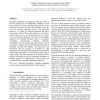Free Online Productivity Tools
i2Speak
i2Symbol
i2OCR
iTex2Img
iWeb2Print
iWeb2Shot
i2Type
iPdf2Split
iPdf2Merge
i2Bopomofo
i2Arabic
i2Style
i2Image
i2PDF
iLatex2Rtf
Sci2ools
AUIC
2006
IEEE
2006
IEEE
Garment-based body sensing using foam sensors
Wearable technology is omnipresent to the user. Thus, it has the potential to be significantly disruptive to the user’s daily life. Context awareness and intuitive device interfaces can help to minimize this disruption, but only when the sensing technology itself is not physically intrusive: i.e., when the interface preserves the user’s homeostatic comfort. This work evaluates a novel foambased sensor for use in body-monitoring for contextaware and gestural interfaces. The sensor is particularly attractive for wearable interfaces due to its positive wearability characteristics (softness, pliability, washability), but less precise than other similar sensors. The sensor is applied in the garment-based monitoring of breathing, shoulder lift (shrug), and directional arm movement, and its accuracy is evaluated in each application. We find the foam technology most successful in detecting the presence of movement events using a single sensor, and less successful in measuring precise, rel...
AUIC 2006 | Intuitive Device Interfaces | Software Engineering | User’s Daily Life | User’s Homeostatic Comfort |
| Added | 10 Jun 2010 |
| Updated | 10 Jun 2010 |
| Type | Conference |
| Year | 2006 |
| Where | AUIC |
| Authors | Lucy E. Dunne, Sarah Brady, Richard Tynan, Kim Lau, Barry Smyth, Dermot Diamond, Gregory M. P. O'Hare |
Comments (0)

